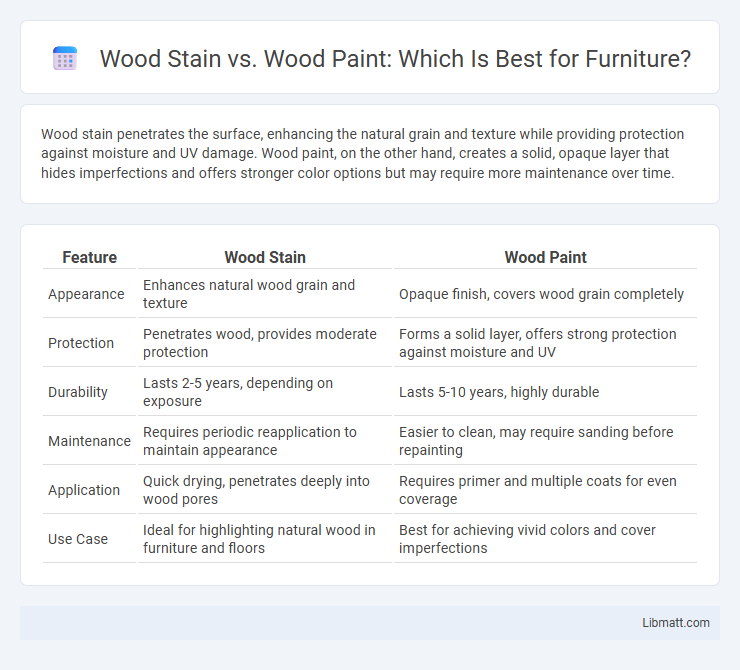Wood stain penetrates the surface, enhancing the natural grain and texture while providing protection against moisture and UV damage. Wood paint, on the other hand, creates a solid, opaque layer that hides imperfections and offers stronger color options but may require more maintenance over time.
Table of Comparison
| Feature | Wood Stain | Wood Paint |
|---|---|---|
| Appearance | Enhances natural wood grain and texture | Opaque finish, covers wood grain completely |
| Protection | Penetrates wood, provides moderate protection | Forms a solid layer, offers strong protection against moisture and UV |
| Durability | Lasts 2-5 years, depending on exposure | Lasts 5-10 years, highly durable |
| Maintenance | Requires periodic reapplication to maintain appearance | Easier to clean, may require sanding before repainting |
| Application | Quick drying, penetrates deeply into wood pores | Requires primer and multiple coats for even coverage |
| Use Case | Ideal for highlighting natural wood in furniture and floors | Best for achieving vivid colors and cover imperfections |
Understanding Wood Stain and Wood Paint
Wood stain penetrates the wood surface to enhance its natural grain while providing color and protection, making it ideal for preserving the wood's texture. Wood paint forms a solid, opaque layer on top of the wood, offering a wide range of colors and superior coverage that conceals imperfections. Choosing between wood stain and wood paint depends on the desired finish, durability needs, and whether maintaining the wood's natural appearance is a priority.
Key Differences Between Wood Stain and Wood Paint
Wood stain penetrates the wood surface, enhancing its natural grain and providing a translucent finish, while wood paint forms an opaque layer that completely covers the wood. Stains offer protection against moisture and UV damage without masking the texture, making them ideal for preserving wood aesthetics. Paint provides a more durable, colorful coating suitable for heavy-duty protection and can prevent surface wear and weathering more effectively than stain.
Appearance and Finish Comparison
Wood stain penetrates the surface, enhancing the natural grain and texture of the wood while providing a translucent finish that highlights its unique patterns. Wood paint, by contrast, offers a solid, opaque layer that covers imperfections and provides uniform color but masks the wood's natural appearance. Your choice depends on whether you prefer a vibrant, natural look with enhanced wood beauty or a bold, solid color with greater coverage and protection.
Application Process: Stain vs Paint
Wood stain penetrates the surface, emphasizing the natural grain with a quicker application that requires less prep work and fewer coats compared to wood paint. Wood paint forms a thicker, protective layer on the wood surface, demanding thorough sanding, priming, and multiple coats for a smooth, durable finish. Your choice between stain and paint impacts the ease of the application process and the final appearance of the wood.
Durability and Protection
Wood stain penetrates the surface to enhance the natural grain while providing moderate protection against moisture and UV damage, making it ideal for outdoor decks and furniture. Wood paint forms a solid, opaque barrier that offers superior durability and protection against weathering, peeling, and cracking. Choosing wood paint ensures your surfaces have a longer lifespan and require less frequent maintenance compared to stain.
Maintenance Requirements
Wood stain requires less maintenance than wood paint because it penetrates the wood surface, offering natural protection against moisture and UV damage while allowing the grain to show through. Painted wood surfaces often need more frequent repainting and touch-ups to prevent peeling, cracking, and fading caused by environmental exposure. Regular cleaning and periodic resealing of stained wood help maintain its appearance and durability, whereas painted wood demands more intensive upkeep to preserve its color and finish.
Best Uses for Wood Stain
Wood stain is best used for enhancing natural wood grain while providing protection and color, especially on outdoor furniture, decks, and hardwood floors. It penetrates deeply into wood fibers, making it ideal for surfaces exposed to weather and wear without creating a thick, opaque layer. Stains are preferred when preserving the authentic look of wood is important alongside durability.
Ideal Situations for Wood Paint
Wood paint is ideal for exterior surfaces exposed to harsh weather conditions as it provides a durable, opaque protective layer that resists moisture, UV rays, and temperature fluctuations. It is also suitable for surfaces requiring vibrant color changes or complete coverage of imperfections on wood, such as furniture, doors, and cabinetry. Unlike wood stain, wood paint offers greater protection against chipping and fading, making it perfect for high-traffic or frequently handled wooden items.
Environmental Impact and Safety
Wood stains generally have a lower environmental impact than wood paints because they contain fewer volatile organic compounds (VOCs) and require less frequent application, reducing chemical exposure. Many wood stains are derived from natural oils and water-based formulas, making them safer for indoor use and minimizing harmful emissions. In contrast, wood paints often include synthetic chemicals and heavier VOC levels, posing greater health risks during application and disposal.
Choosing the Right Option for Your Project
Wood stain penetrates the surface, enhancing the natural grain and providing long-lasting protection against moisture and UV damage, making it ideal for outdoor furniture and decks. Wood paint forms a solid, opaque coating that offers superior color options and durability, perfect for indoor furniture and surfaces requiring uniform coverage. Consider the desired aesthetic, environmental exposure, and maintenance requirements to select the best option for your wood project.
wood stain vs wood paint Infographic

 libmatt.com
libmatt.com